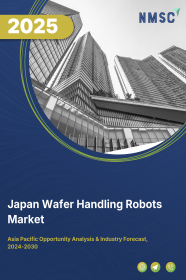
Japan Wafer Handling Robots Market by Product Type (Vacuum Wafer Handling Robots and Atmospheric Wafer Handling Robots), by Number of Arms (Single Arm and Dual Arm), by Robot Type (Linear Robots, SCARA Robots, Articulated Robots, Cylindrical Robot, and Others), by Operation (Motor Driven and Belt Driven), by Installation (Free Standing and Integrated), by End Use (Integrated Device Manufacturer (IDM) and Foundries) – Opportunity Analysis and Industry Forecast, 2024–2030
Industry: ICT & Media | Publish Date: 15-Feb-2025 | No of Pages: 169 | No. of Tables: 132 | No. of Figures: 97 | Format: PDF | Report Code : IC2085
US Tariff Impact on Japan Wafer Handling Robots Market
Trump Tariffs Are Reshaping Global Business
Japan Wafer Handling Robots Market Overview
Japan Wafer Handling Robots Market size was valued at USD 152.6 million in 2023, and is predicted to reach USD 293.0 million by 2030, at a CAGR of 9.0% from 2024 to 2030. Also, the market size was 3984.0 units in 2023, and is predicted to reach 10722.0 units by 2030, with a CAGR of 13.4% from 2024 to 2030. A wafer handling robot represents a specialized robotic solution designed to streamline the complex procedures inherent in semiconductor manufacturing. These robots demonstrate exceptional proficiency in executing precise movements and positioning tasks with fragile semiconductor wafers.
Their significance lies in their pivotal role in the creation of top-tier integrated circuits and microelectronic devices. Operating within pristine cleanroom environments, they incorporate a diverse range of end effectors, sensors, and vision systems to securely grasp, inspect, and manipulate wafers, all while mitigating the risks of damage or contamination. By seamlessly integrating with other fabrication equipment, these robots not only boost operational efficiency and minimize errors but also foster the consistent production of cutting-edge semiconductor technologies that power an extensive array of contemporary devices.
Presence of Key Market Players Propels the Growth of the Japan Wafer Handling Robots Market
The presence of leading market players such as Kawasaki Heavy Industries, Rexxam Co., Ltd, and Yaskawa Electric Corporation is driving growth in the wafer handling robots market through innovative product launches and strategic initiatives. For example, in May 2020, Yaskawa Electric introduced the "SEMISTAR-GEKKO MD124D," a cutting-edge 5-axis single-arm clean robot specifically designed for handling semiconductor substrate wafers. This robot is capable of transferring 300 mm semiconductor wafers with precision, thereby ensuring efficient transportation and enhancing overall productivity in semiconductor manufacturing processes.
Growth of Semiconductor Equipment Market in Japan Drives the Growth of the Japan Wafer Handling Robots Market
Japan, being the fourth largest global semiconductor manufacturing equipment sales market, significantly contributes to the demand for wafer handling robots. The Semiconductor Equipment Association of Japan ("SEAJ") reported a record-breaking level of semiconductor manufacturing equipment sales in Japan in 2021, reaching $33 billion.
This remarkable growth underscores Japan's pivotal role in the semiconductor industry and reflects the increasing demand for advanced automation solutions, including wafer handling robots, to support semiconductor manufacturing processes. As Japan continues to invest in semiconductor equipment and technology, the wafer handling robots market is poised for further expansion.
High Initial Cost Restrains the Market Growth
The substantial expense associated with wafer handling robots poses a significant hurdle to market expansion. The upfront investment necessary to procure, integrate, and sustain these advanced automation systems represents a considerable financial challenge for companies, particularly those with constrained budgets. This financial barrier has the potential to dissuade prospective adopters from entering the market or scaling up their automation capabilities.
Incorporation of Advanced Technologies such as Computer Vision and AI to Enhance Precision
Incorporating cutting-edge technologies such as Artificial Intelligence (AI), computer vision, and the Internet of Things (IoT) into robots presents extensive opportunities for the Japan wafer handling robots market expansion. These integrations empower wafer handling robots to streamline processes, increase operational efficiency, and enable predictive maintenance. AI algorithms play a vital role in refining robot movements, improving quality control by identifying defects in real-time, and predicting maintenance needs.
Computer vision ensures accurate handling of wafers and precise object recognition, even in complex operational settings, while IoT connectivity enables real-time monitoring, data exchange, and predictive maintenance, thereby reducing downtime. Additionally, advanced safety features, data analytics capabilities, and enhancements in energy efficiency further underscore the importance of wafer handling robots as indispensable assets within the dynamic semiconductor manufacturing landscape.
Competitive Landscape
The Japan wafer handling robots industry comprises various market players, such as include Kawasaki Heavy Industries, Ltd., Nidec Instruments Corporation, Yaskawa Electric Corp., RORZE Corporation, DAIHEN Corporation, Hirata Corporation, Rexxam Co., Ltd., KUKA AG, ULVAC, Inc., and Stäubli International AG.
Japan Wafer Handling Robots Market Key Segments
By Product Type
-
Vacuum Wafer Handling Robots
-
Atmospheric Wafer Handling Robots
By Number of Arms
-
Single Arm
-
Dual Arm
By Robot Type
-
Linear Robots
-
SCARA Robots
-
Articulated Robots
-
Cylindrical Robot
-
Others
By Operation
-
Motor Driven
-
Belt Driven
-
Stainless Steel Belts
-
Rubber Belts
-
Polymer Belts
-
By Installation
-
Free Standing
-
Integrated
By Wafer Size
-
Up to 100 mm
-
150 mm
-
200 mm
-
300 mm
-
Above 300 mm
By Semiconductor Process
-
Oxidation (Deposition)
-
Lithography
-
Etching, Cleaning, Polishing
-
Inspection & Testing
-
Assembly & Packaging
By End Use
-
Integrated Device Manufacturer (IDM)
-
Foundries
REPORT SCOPE AND SEGMENTATION:
|
Parameters |
Details |
|
Market Size in 2023 |
USD 152.6 Million |
|
Revenue Forecast in 2030 |
USD 293.0 Million |
|
Growth Rate |
CAGR of 9.0% from 2024 to 2030 |
|
Market Volumes in 2023 (units) |
3984.0 |
|
Volumes Forecast in 2030 (units) |
10722.0 |
|
Growth Rate |
14.3% |
|
Analysis Period |
2023–2030 |
|
Base Year Considered |
2023 |
|
Forecast Period |
2024–2030 |
|
Market Size Estimation |
Million (USD) |
|
Growth Factors |
|
|
Companies Profiled |
10 |
|
Market Share |
Available for 10 companies |
|
Customization Scope |
Free customization (equivalent up to 80 working hours of analysts) after purchase. Addition or alteration to country, regional, and segment scope. |
|
Pricing and Purchase Options |
Avail customized purchase options to meet your exact research needs. |
KEY PLAYERS
-
Kawasaki Heavy Industries, Ltd.
-
Nidec Instruments Corporation
-
Yaskawa Electric Corp.
-
RORZE Corporation
-
DAIHEN Corporation
-
Hirata Corporation
-
Rexxam Co., Ltd.
-
KUKA AG
-
ULVAC, Inc.
-
Stäubli International AG

















 Speak to Our Analyst
Speak to Our Analyst





















